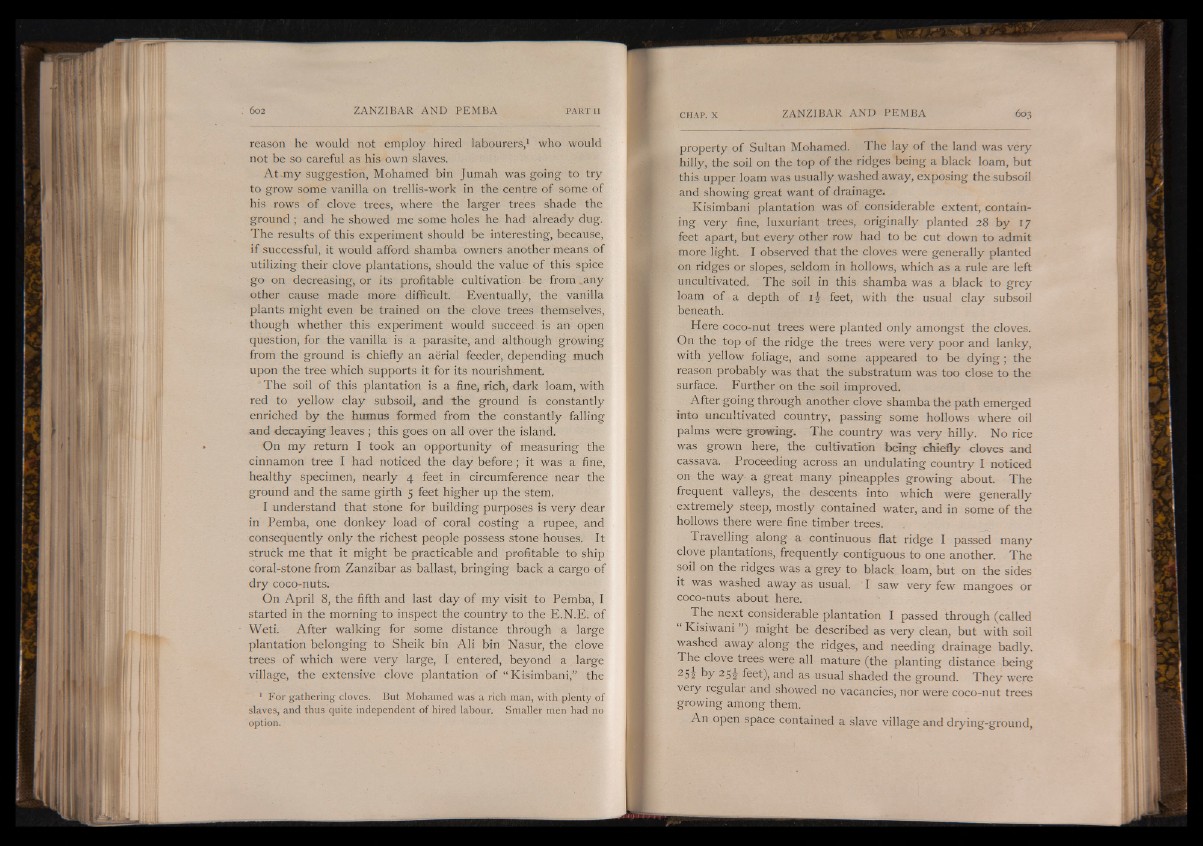
reason he would not employ hired labourers,1 who would
not be so careful as his own slaves.
A t -my suggestion, Mohamed bin Jumah was going to try
to grow some vanilla on trellis-work in the centre of some of
his rows of clove trees, where the larger trees shade the
ground ; and he showed me some holes he had already dug.
The results of this experiment should be interesting, because,
if successful, it would afford shamba owners another means of
utilizing their clove plantations, should the value of this spice
go on decreasing, or its profitable cultivation- be from ,any
other cause made more difficult. Eventually, the vanilla
plants might even be trained on the clove trees themselves,
though whether this experiment would succeed is an open
question, for the vanilla is a parasite, and although growing
from the ground is chiefly an aerial feeder, depending much
upon the tree which supports it for its nourishment
The soil of this plantation is a fine, rich, dark loam, with
red to yellow clay subsoil, and the ground is constantly
enriched by the humus formed from the constantly falling
and decaying leaves ; this goes on all over the island.
On my return I took an opportunity of measuring the
cinnamon tree I had noticed the day before; it was a fine,
healthy specimen, nearly 4 feet in circumference near the
ground and the same girth 5 feet higher up the stem.
I understand that stone for building purposes is very dear
in Pemba, one donkey load of coral costing a rupee, and
consequently only the richest people possess stone houses. It
struck me that it might be practicable and profitable to ship
coral-stone from Zanzibar as ballast, bringing back a cargo of
dry coco-nuts.
On April 8, the fifth and last day of my visit to Pemba, I
started in the morning to inspect the country to the E.N.E. of
Weti. After walking for some distance through a large
plantation belonging to Sheik bin Ali bin Nasur, the clove
trees of which were very large, I entered, beyond a large
village, the extensive clove plantation of “ Kisimbani,” the
1 For gathering cloves. But Mohamed was a rich man, with plenty of
slaves, and thus quite independent of hired labour. Smaller men had 110
option.
property of Sultan Mohamed. The lay of the land was very
hilly, the soil on the top of the ridges being a black loam, but
this upper loam was usually washed away, exposing the subsoil
and showing great want of drainage.
Kisimbani plantation was of considerable extent, containing
very fine, luxuriant trees, originally planted 28 by 17
feet apart, but every other row had to be cut down to admit
more light. I observed that the cloves were generally planted
on ridges or slopes, seldom in hollows, which as a rule are left
uncultivated. The soil in this shamba was a black to grey
loam of a depth of | | feet, with the usual clay subsoil
beneath.
Here coco-nut trees were planted only amongst the cloves.
On the top of the ridge the trees were very poor and lanky,
with yellow foliage, and some appeared to be dying; the
reason probably was that the substratum was too close to the
surface. Further on the soil improved.
After going through another clove shamba the path emerged
into uncultivated country, passing some hollows where oil
palms were growing. The country was very hilly. No rice
was grown here, the cultivation being chiefly cloves and
cassava. Proceeding across an undulating country I noticed
on the way- a great many pineapples growing about. The
frequent valleys, the descents into which were generally
extremely steep, mostly contained water, and in some of the
hollows there were fine timber trees.
Travelling along a continuous flat ridge I passed many
clove plantations, frequently contiguous to one another. The
soil on the ridges was a grey to black loam, but on the sides
it was washed away as usual. I saw very few mangoes or
coco-nuts about here.
The next considerable plantation I passed through (called
Kisiwani ) might be described as very clean, but with soil
washed away along the ridges, and needing drainage badly.
The clove trees were all mature (the planting distance being
2Si by 25J feet), and as usual shaded the ground. They were
very regular and showed no vacancies, nor were coco-nut trees
growing among them.
An open space contained a slave village and drying-ground,